Design of a 5G Sub-6 GHz Vehicular Cellular Antenna Element with Consistent Radiation Pattern Using Characteristic Mode Analysis
Abstract
1. Introduction
1.1. Introduction to the Theory of Characteristic Modes
1.2. Automotive Requirements and Constraints
1.3. Paper Organization
2. Materials and Methods
2.1. Design Description
2.2. Antenna Characteristic Mode Analysis
2.3. Optimization Method and Parametric Study
2.3.1. Long-Structure Tuning
2.3.2. Short-Structure Tuning
2.3.3. Combining Long and Short Structures
3. Results
3.1. Antenna Evaluation Setup
3.2. VSWR
3.3. Radiation Pattern
3.4. Performance across the Frequency Range
4. Conclusions
Author Contributions
Funding
Conflicts of Interest
References
- Abdelkader, G.; Elgazzar, K.; Khamis, A. Connected Vehicles: Technology Review, State of the Art, Challenges and Opportunities. Sensors 2021, 21, 7712. [Google Scholar] [CrossRef] [PubMed]
- Kumar, S.; Dixit, A.S.; Malekar, R.R.; Raut, H.D.; Shevada, L.K. Fifth Generation Antennas: A Comprehensive Review of Design and Performance Enhancement Techniques. IEEE Access 2020, 8, 163568–163593. [Google Scholar] [CrossRef]
- Rumsey, V. Frequency Independent Antennas. In Proceedings of the 1958 IRE International Convention Record, New York, NY, USA, 21–25 March 1966; Volume 5, pp. 114–118. [Google Scholar]
- Artner, G.; Kotterman, W.; Del Galdo, G.; Hein, M.A. Automotive Antenna Roof for Cooperative Connected Driving. IEEE Access 2019, 7, 20083–20090. [Google Scholar] [CrossRef]
- Suh, S.-Y.; Stutzman, W.L.; Davis, W.A. A new ultrawideband printed monopole antenna: The planar inverted cone antenna (PICA). IEEE Trans. Antennas Propag. 2004, 52, 1361–1364. [Google Scholar] [CrossRef]
- Sanz-Izquierdo, B.; Leelaratne, R. Evaluation of Wideband LTE Antenna Configurations for Vehicle Applications. In Proceedings of the 2013 Loughborough Antennas & Propagation Conference (LAPC), Loughborough, UK, 11–12 November 2013; pp. 383–387. [Google Scholar]
- Michel, A.; Nepa, P.; Gallo, M.; Moro, I.; Filisan, A.P.; Zamberlan, D. Printed Wideband Antenna for LTE-Band Automotive Applications. IEEE Antennas Wirel. Propag. Lett. 2017, 16, 1245–1248. [Google Scholar] [CrossRef]
- Cheng, Y.; Lu, J.; Wang, C. Design of a Multiple Band Vehicle-Mounted Antenna. Int. J. Antennas Propag. 2019, 2019, 6098014. [Google Scholar] [CrossRef]
- Melli, F.; Lenzini, S.; Cerretelli, M.; Coscelli, E.; Notari, A.; Selleri, S.; Vincetti, L. Low Profile Wideband 3D Antenna for Roof-Top LTE Vehicular Applications. In Proceedings of the 2019 IEEE-APS Topical Conference on Antennas and Propagation in Wireless Communications (APWC), Granada, Spain, 9–13 September 2019; pp. 157–159. [Google Scholar]
- Goncharova, I.; Lindenmeier, S. A High-Efficient 3-D Nefer-Antenna for LTE Communication on a Car. In Proceedings of the 8th European Conference on Antennas and Propagation (EuCAP 2014), The Hague, The Netherlands, 6–11 April 2014; pp. 3273–3277. [Google Scholar]
- Preradovic, D.; Aloi, D.N. Ultra Wide Planar Monopole Antenna for LTE Application in Automobile. In Proceedings of the 2018 IEEE International Conference on Electro/Information Technology (EIT), Rochester, MI, USA, 3–5 May 2018; pp. 774–777. [Google Scholar]
- Navarro-Mendez, D.V.; Carrera-Suarez, L.F.; Antonino-Daviu, E.; Ferrando-Bataller, M.; Baquero-Escudero, M.; Gallo, M.; Zamberlan, D. Compact Wideband Vivaldi Monopole for LTE Mobile Communications. IEEE Antennas Wirel. Propag. Lett. 2015, 14, 1068–1071. [Google Scholar] [CrossRef]
- Luo, W.; Chen, W.; Feng, Y.; Yang, Y. A novel automobile antenna for vehicles communication of IoT systems in 5G network. EURASIP J. Wirel. Commun. Netw. 2020, 2020, 218. [Google Scholar] [CrossRef]
- Khalifa, M.O.; Yacoub, A.M.; Aloi, D.N. A Multiwideband Compact Antenna Design for Vehicular Sub-6 GHz 5G Wireless Systems. IEEE Trans. Antennas Propag. 2021, 69, 8136–8142. [Google Scholar] [CrossRef]
- Ibrahim, A.S.; Yacoub, A.M.; Aloi, D.N. A 3-Dimensional Multiband Antenna for Vehicular 5G Sub-6 GHz/GNSS/V2X Applications. Int. J. Antennas Propag. 2022, 2022, 5609110. [Google Scholar] [CrossRef]
- Garbacz, R.; Turpin, R. A generalized expansion for radiated and scattered fields. IEEE Trans. Antennas Propag. 1971, 19, 348–358. [Google Scholar] [CrossRef]
- Harrington, R.F.; Mautz, J.R. Theory and Computation of Characteristic Modes for Conducting Bodies. IEEE Trans. Antennas Propag. 1971, 19, 622–628. [Google Scholar] [CrossRef]
- Harrington, R.; Mautz, J. Computation of characteristic modes for conducting bodies. IEEE Trans. Antennas Propag. 1971, 19, 629–639. [Google Scholar] [CrossRef]
- Yan, S.; Vandenbosch, G.A.E. Design of Wideband Button Antenna Based on Characteristic Mode Theory. IEEE Trans. Biomed. Circuits Syst. 2018, 12, 1383–1391. [Google Scholar] [CrossRef]
- Prakoso, T.; Sabila, L.Y.; Damayanti, D.A.; Sofwan, A.; Riyadi, M.A.; Sudjadi; Sukiswo; Sinuraya, E.W.; Karnoto. Bandwidth Enhancement of Circular Microstrip Antenna Using Characteristic Mode Analysis. In Proceedings of the 2017 4th International Conference on Information Technology, Computer, and Electrical Engineering (ICITACEE), Semarang, Indonesia, 18–19 October 2017; pp. 312–316. [Google Scholar]
- Zhang, Q.; Ma, R.; Su, W.; Gao, Y. Design of a Multimode UWB Antenna Using Characteristic Mode Analysis. IEEE Trans. Antennas Propag. 2018, 66, 3712–3717. [Google Scholar] [CrossRef]
- Li, T.; Chen, Z.N. A Dual-Band Metasurface Antenna Using Characteristic Mode Analysis. IEEE Trans. Antennas Propag. 2018, 66, 5620–5624. [Google Scholar] [CrossRef]
- Perli, B.R.; Rao, A.M. Characteristic Mode Analysis of Wideband Microstrip Antenna. Prog. Electromagn. Res. C 2019, 97, 201–212. [Google Scholar] [CrossRef]
- Li, H.; Miers, Z.T.; Lau, B.K. Design of Orthogonal MIMO Handset Antennas Based on Characteristic Mode Manipulation at Frequency Bands Below 1 GHz. IEEE Trans. Antennas Propag. 2014, 62, 2756–2766. [Google Scholar] [CrossRef]
- He, D.; Yu, Y.; Mao, S. Characteristic Mode Analysis of a MIMO Antenna with DGS. In Proceedings of the 2021 IEEE International Symposium on Antennas and Propagation and USNC-URSI Radio Science Meeting (APS/URSI), Singapore, 4–10 December 2021; pp. 1143–1144. [Google Scholar]
- Ethier, J.; Lanoue, E.; McNamara, D. MIMO handheld antenna design approach using characteristic mode concepts. Microw. Opt. Technol. Lett. 2008, 50, 1724–1727. [Google Scholar] [CrossRef]
- Dicandia, F.A.; Genovesi, S.; Monorchio, A. Null-Steering Antenna Design Using Phase-Shifted Characteristic Modes. IEEE Trans. Antennas Propag. 2016, 64, 2698–2706. [Google Scholar] [CrossRef]
- Dicandia, F.A.; Genovesi, S.; Monorchio, A. Advantageous Exploitation of Characteristic Modes Analysis for the Design of 3-D Null-Scanning Antennas. IEEE Trans. Antennas Propag. 2017, 65, 3924–3934. [Google Scholar] [CrossRef]
- Dicandia, F.A.; Genovesi, S.; Monorchio, A. Efficient Excitation of Characteristic Modes for Radiation Pattern Control by Using a Novel Balanced Inductive Coupling Element. IEEE Trans. Antennas Propag. 2018, 66, 1102–1113. [Google Scholar] [CrossRef]
- Yang, X.; Liu, Y.; Gong, S.X. Design of a Wideband Omnidirectional Antenna With Characteristic Mode Analysis. IEEE Antennas Wirel. Propag. Lett. 2018, 17, 993–997. [Google Scholar] [CrossRef]
- Sheng, H.; Chen, Z.N. Radiation Pattern Improvement of Cross-Band Dipoles Using Inductive-Loading Mode-Suppression Method. IEEE Trans. Antennas Propag. 2019, 67, 3467–3471. [Google Scholar] [CrossRef]
- Sheng, H.; Chen, Z.N. Improving Radiation Pattern Roundness of a Monopole Antenna Placed Off-Center Above a Circular Ground Plane Using Characteristic Mode Analysis. IEEE Trans. Antennas Propag. 2021, 69, 1135–1139. [Google Scholar] [CrossRef]
- Lin, F.H.; Chen, Z.N. A Method of Suppressing Higher Order Modes for Improving Radiation Performance of Metasurface Multiport Antennas Using Characteristic Mode Analysis. IEEE Trans. Antennas Propag. 2018, 66, 1894–1902. [Google Scholar] [CrossRef]
- Wen, D.; Hao, Y.; Wang, H.; Zhou, H. Design of a Wideband Antenna With Stable Omnidirectional Radiation Pattern Using the Theory of Characteristic Modes. IEEE Trans. Antennas Propag. 2017, 65, 2671–2676. [Google Scholar] [CrossRef]
- Antonino-Daviu, E.; Fabres, M.; Ferrando-Bataller, M.; Penarrocha, V.M.R. Modal Analysis and Design of Band-Notched UWB Planar Monopole Antennas. IEEE Trans. Antennas Propag. 2010, 58, 1457–1467. [Google Scholar] [CrossRef]
- Wu, W.; Zhang, Y.P. Analysis of Ultra-Wideband Printed Planar Quasi-Monopole Antennas Using the Theory of Characteristic Modes. IEEE Antennas Propag. Mag. 2010, 52, 67–77. [Google Scholar]
- Li, W.; Liu, Y.; Li, J.; Ye, L.; Liu, Q.H. Modal Proportion Analysis in Antenna Characteristic Mode Theory. Int. J. Antennas Propag. 2019, 2019, 7069230. [Google Scholar] [CrossRef]
- Khan, I.; Rodrigues, J.J.P.C.; Al-Muhtadi, J.; Khattak, M.I.; Khan, Y.; Altaf, F.; Mirjavadi, S.S.; Choi, B.J. A Robust Channel Estimation Scheme for 5G Massive MIMO Systems. Wirel. Commun. Mob. Comput. 2019, 2019, 3469413. [Google Scholar] [CrossRef]
- Zeng, Y.; Yi, H.; Xia, Z.; Wang, S.; Ai, B.; Fei, D.; Li, W.; Guan, K. Measurement and Simulation for Vehicle-to-Infrastructure Communications at 3.5 GHz for 5G. Wirel. Commun. Mob. Comput. 2020, 2020, 8851600. [Google Scholar] [CrossRef]
- Computer Simulation Technology (CST). Electromagnetic Field Simulation Software. Available online: http://www.cst.com (accessed on 1 November 2022).



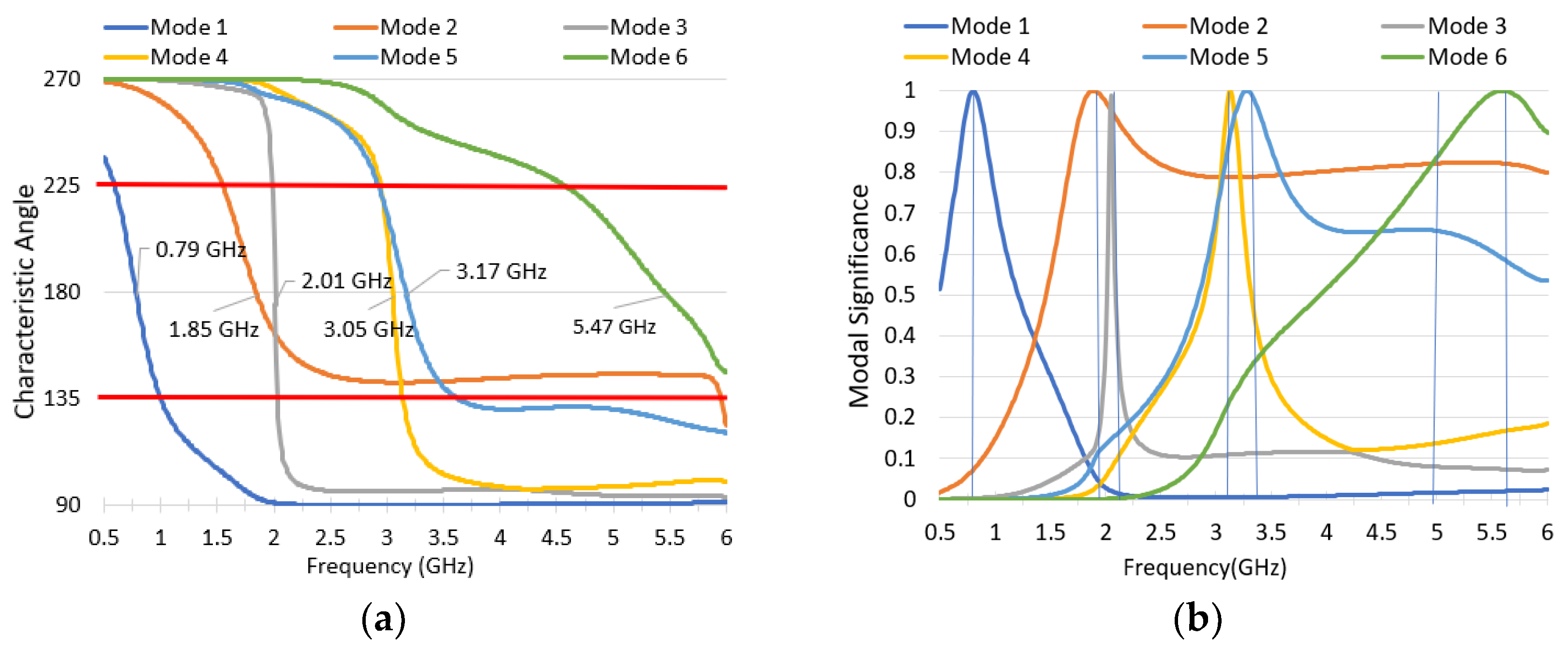
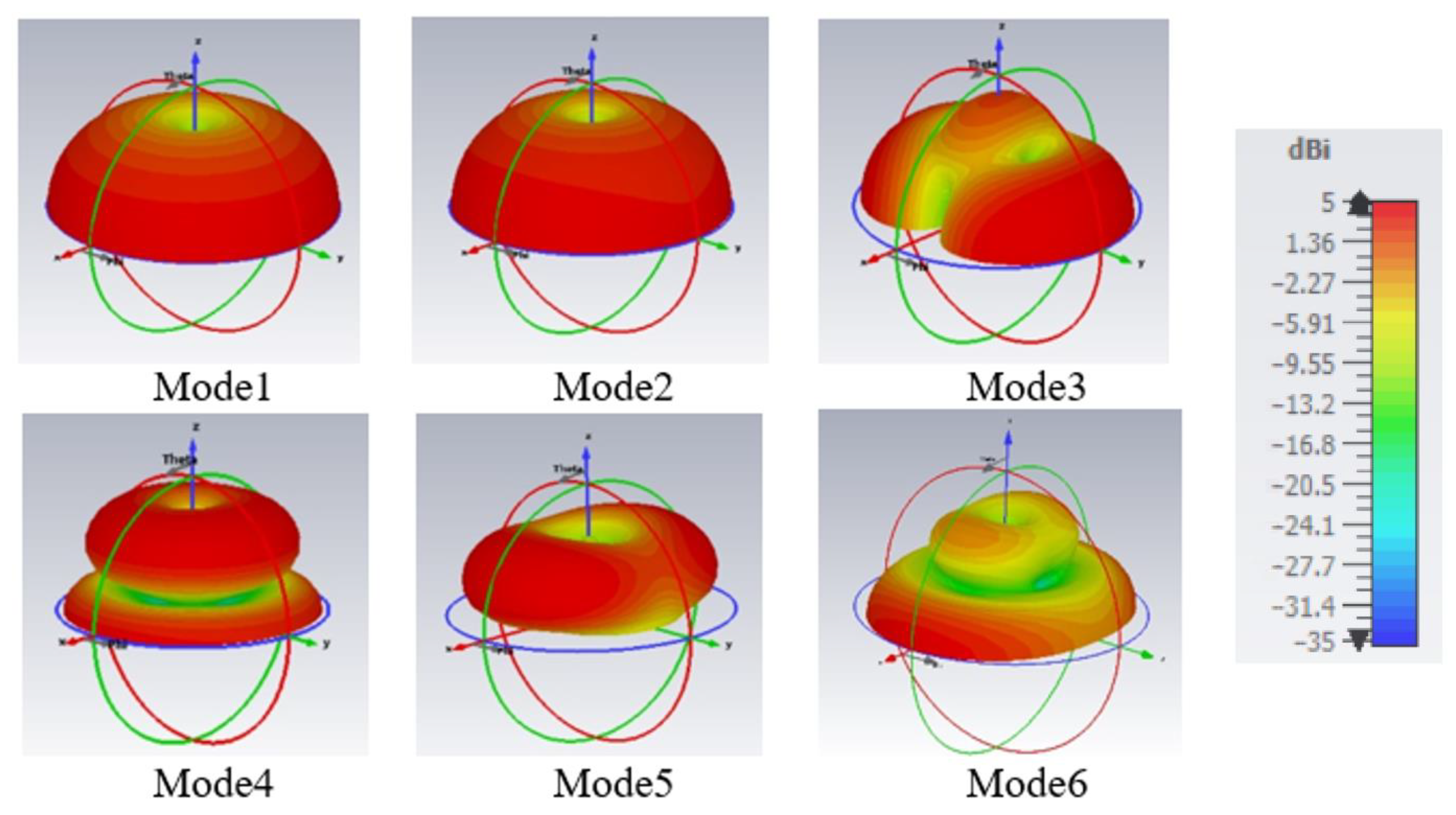
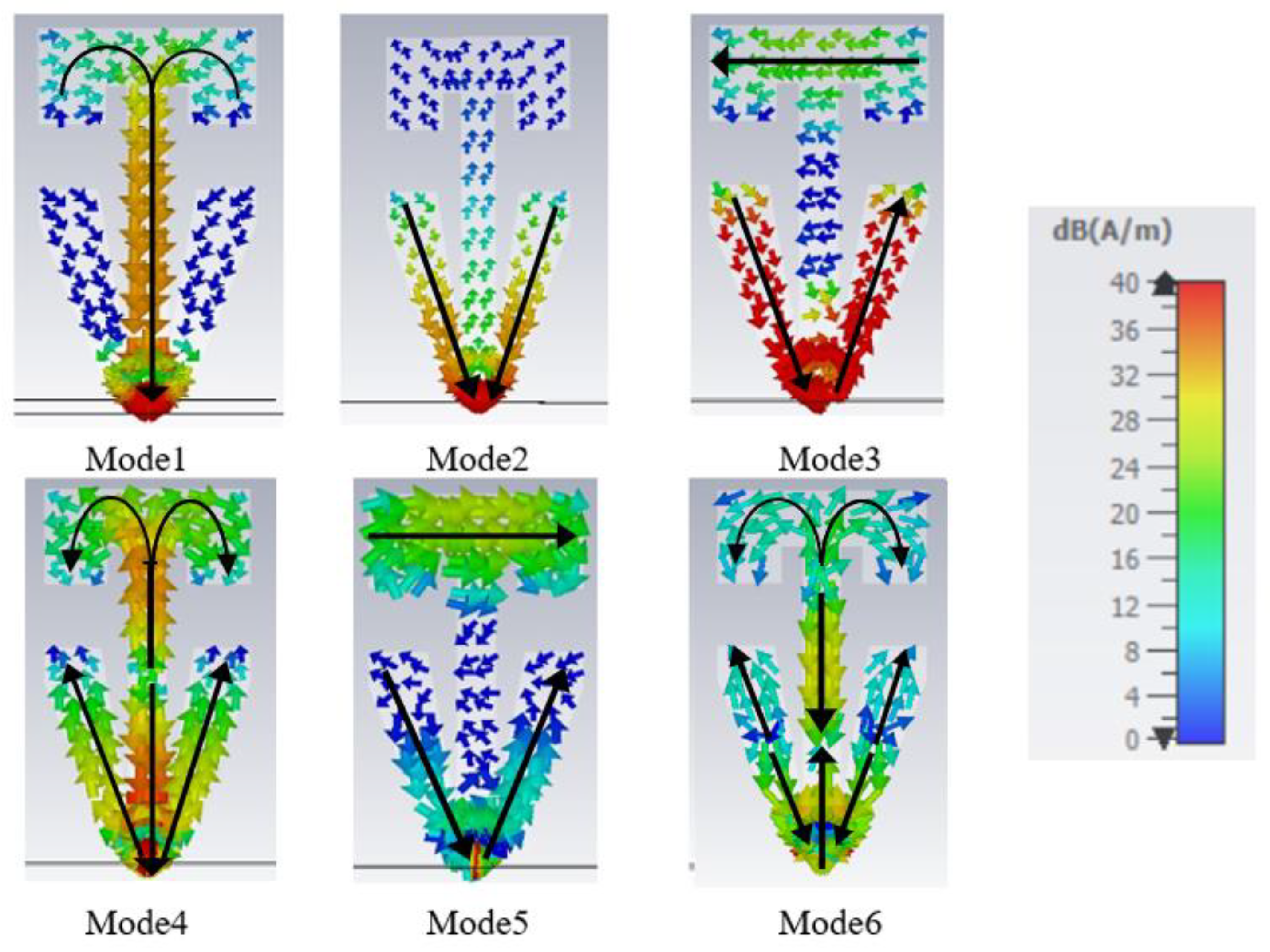






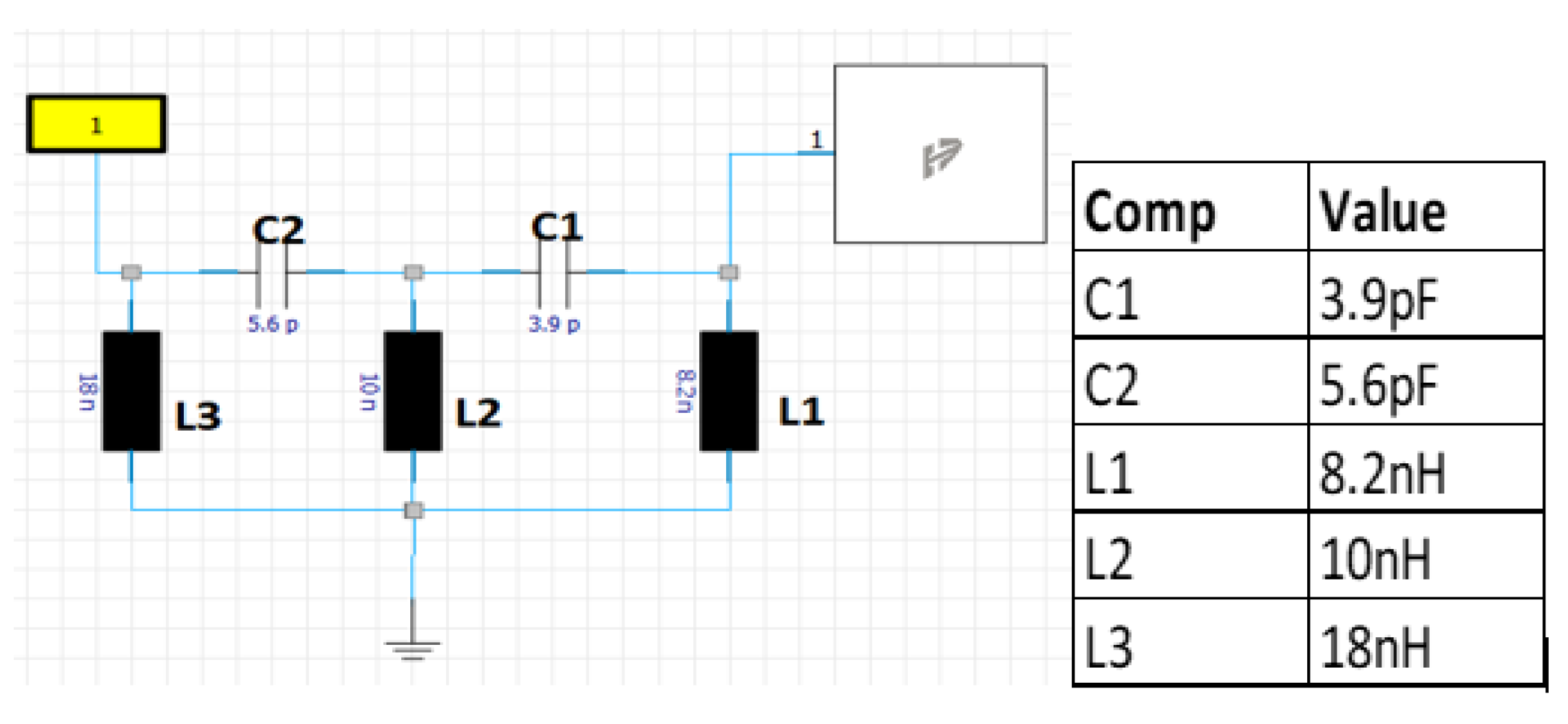
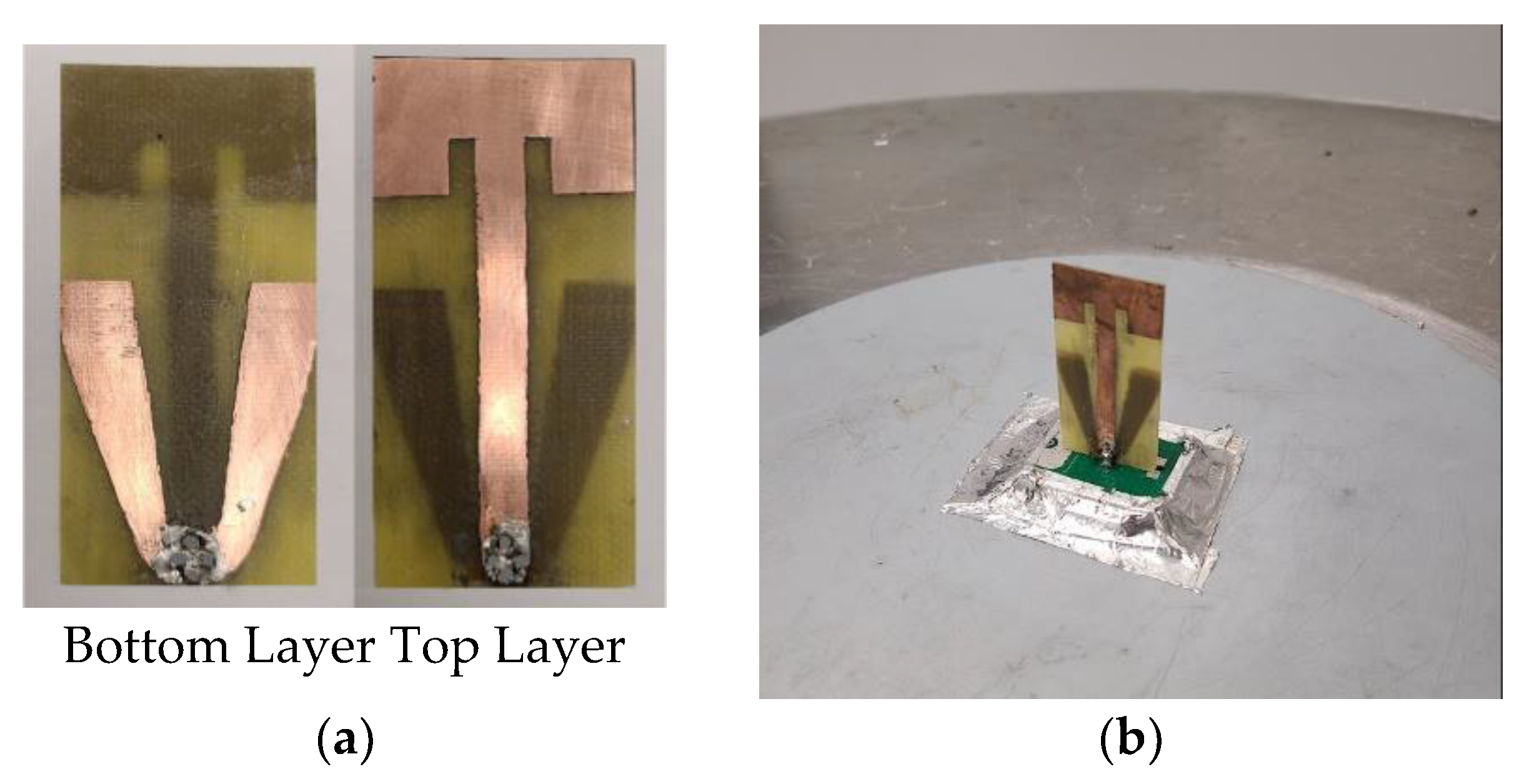
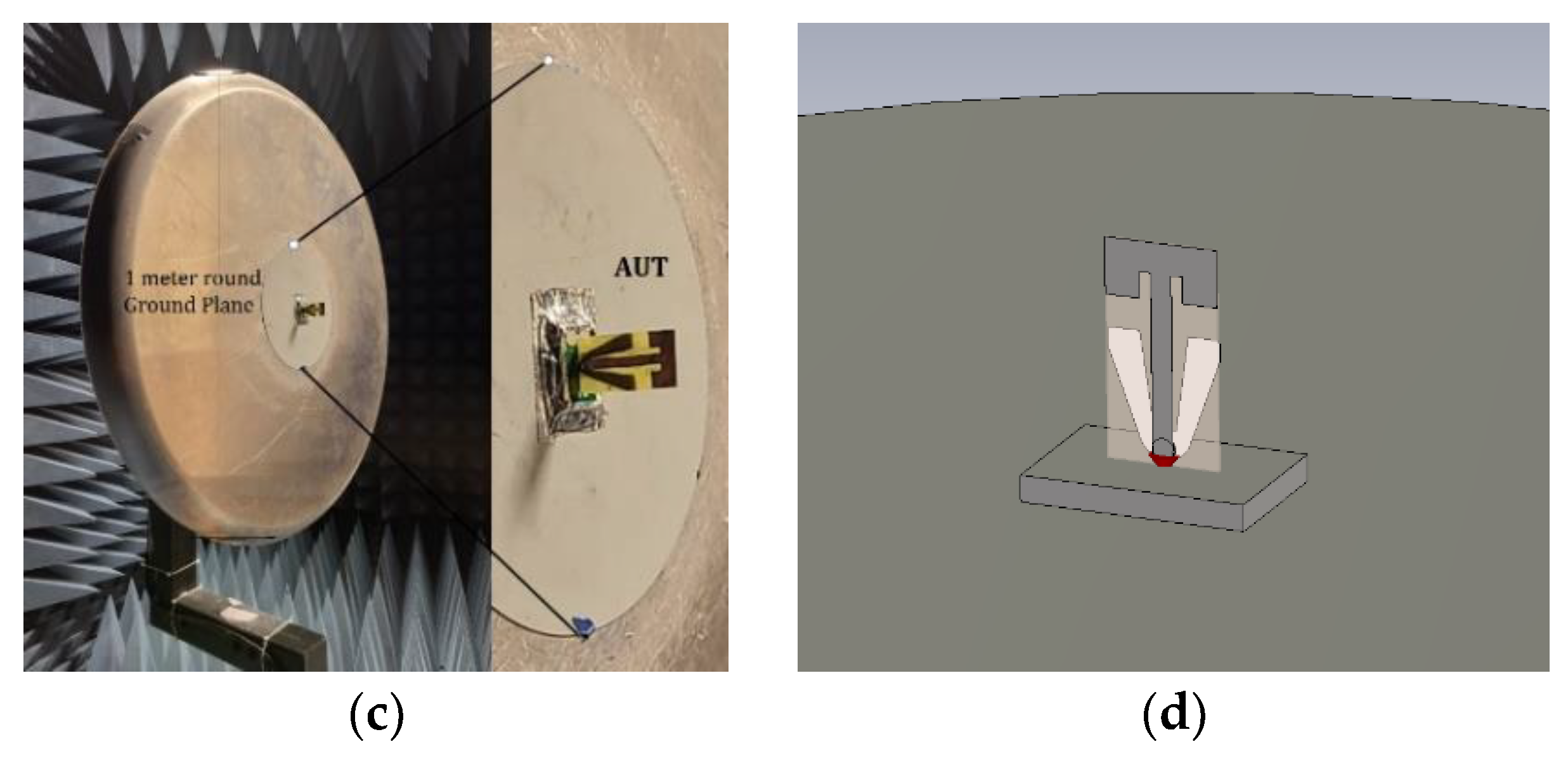
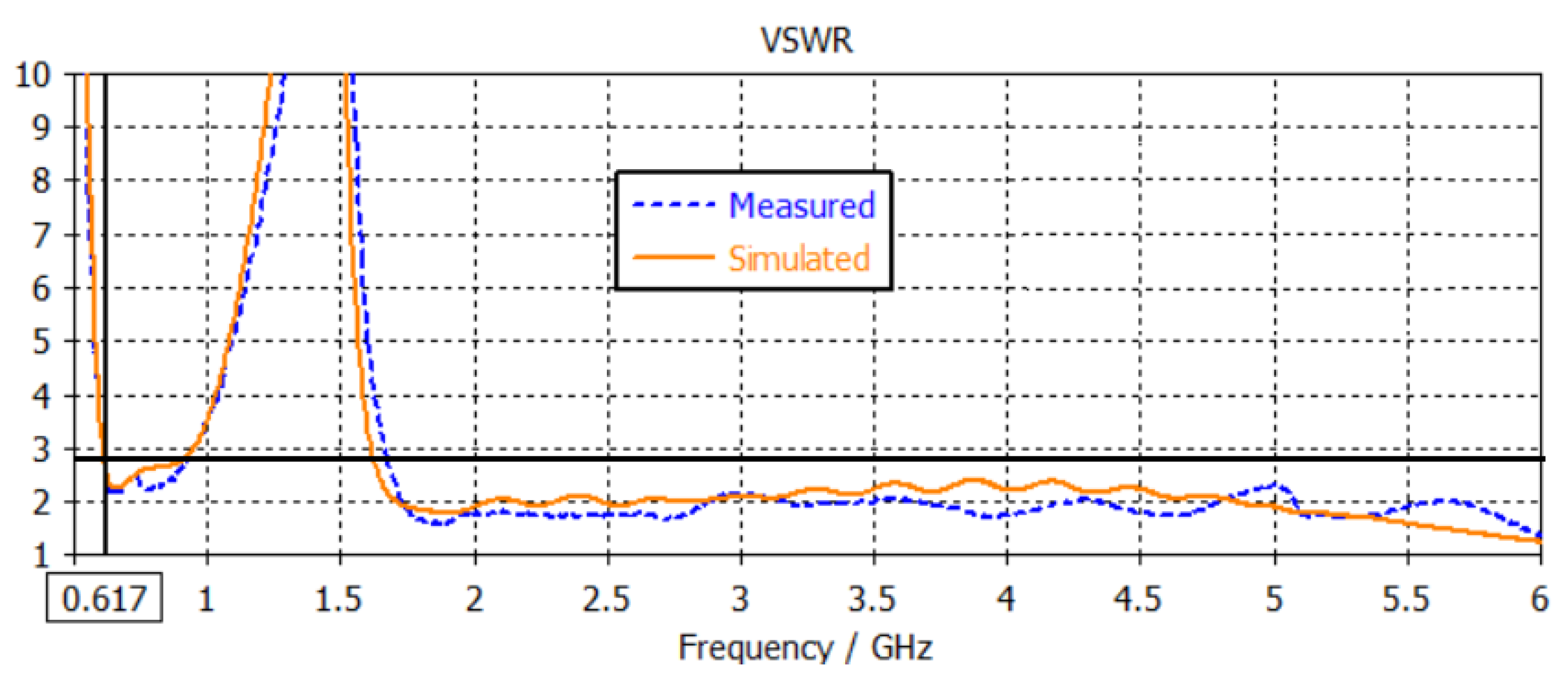
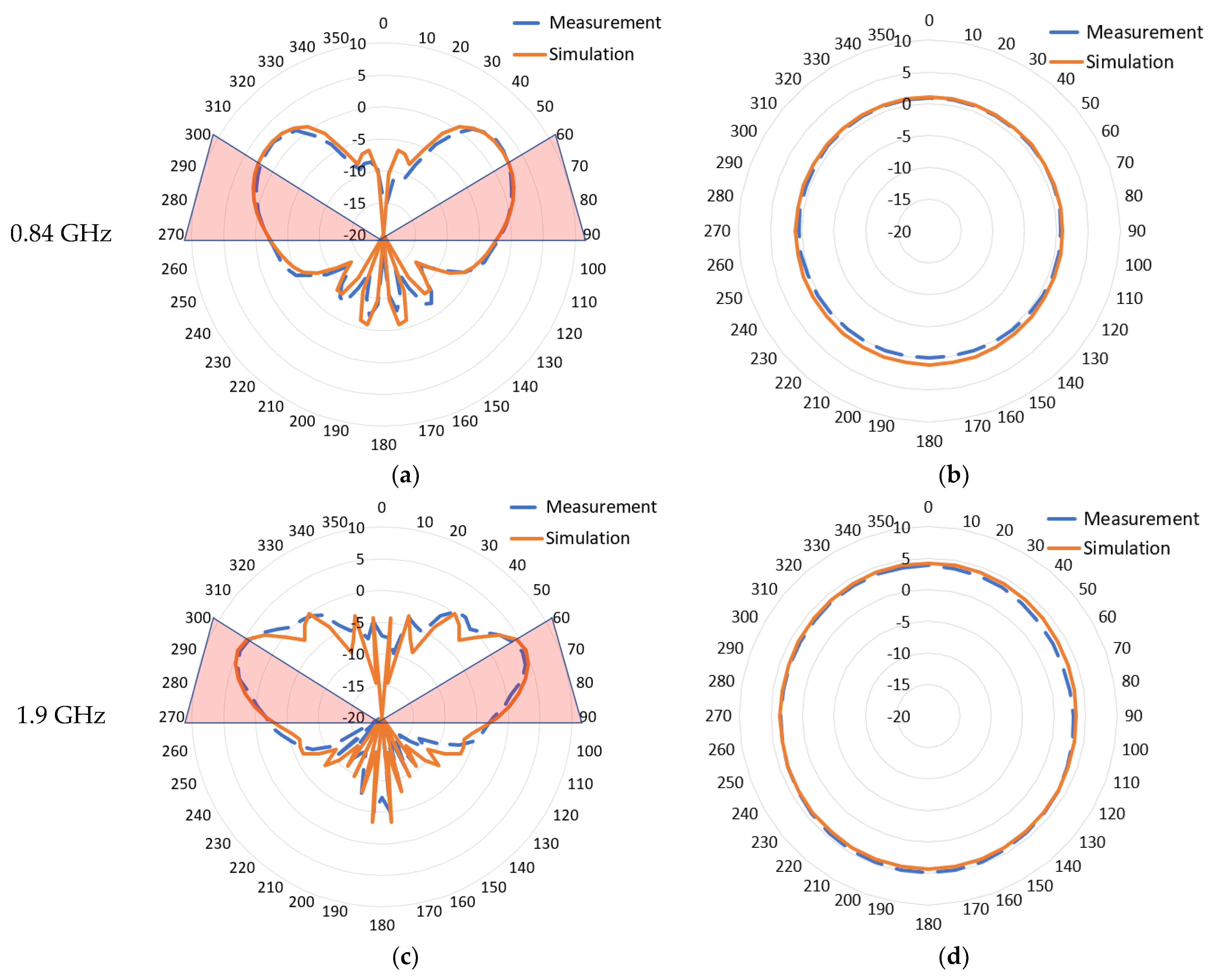

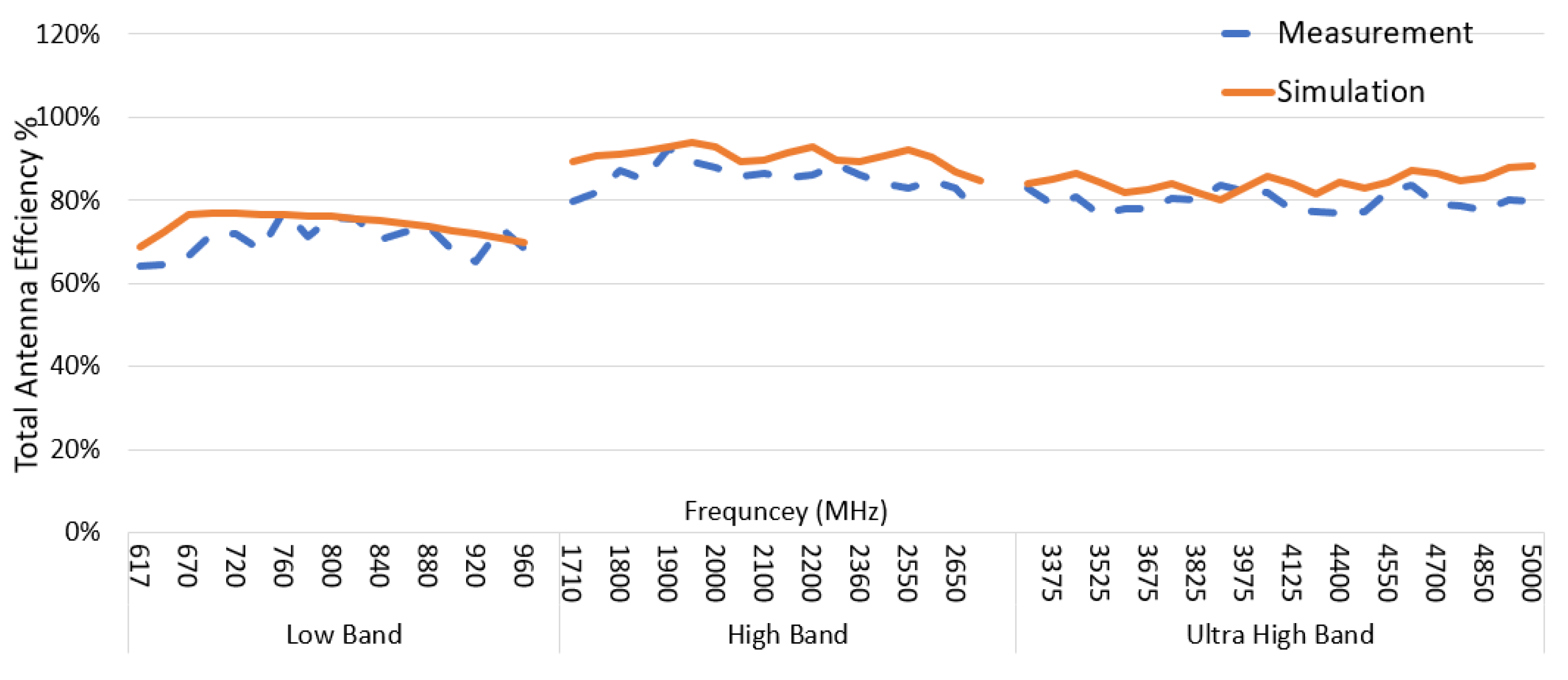

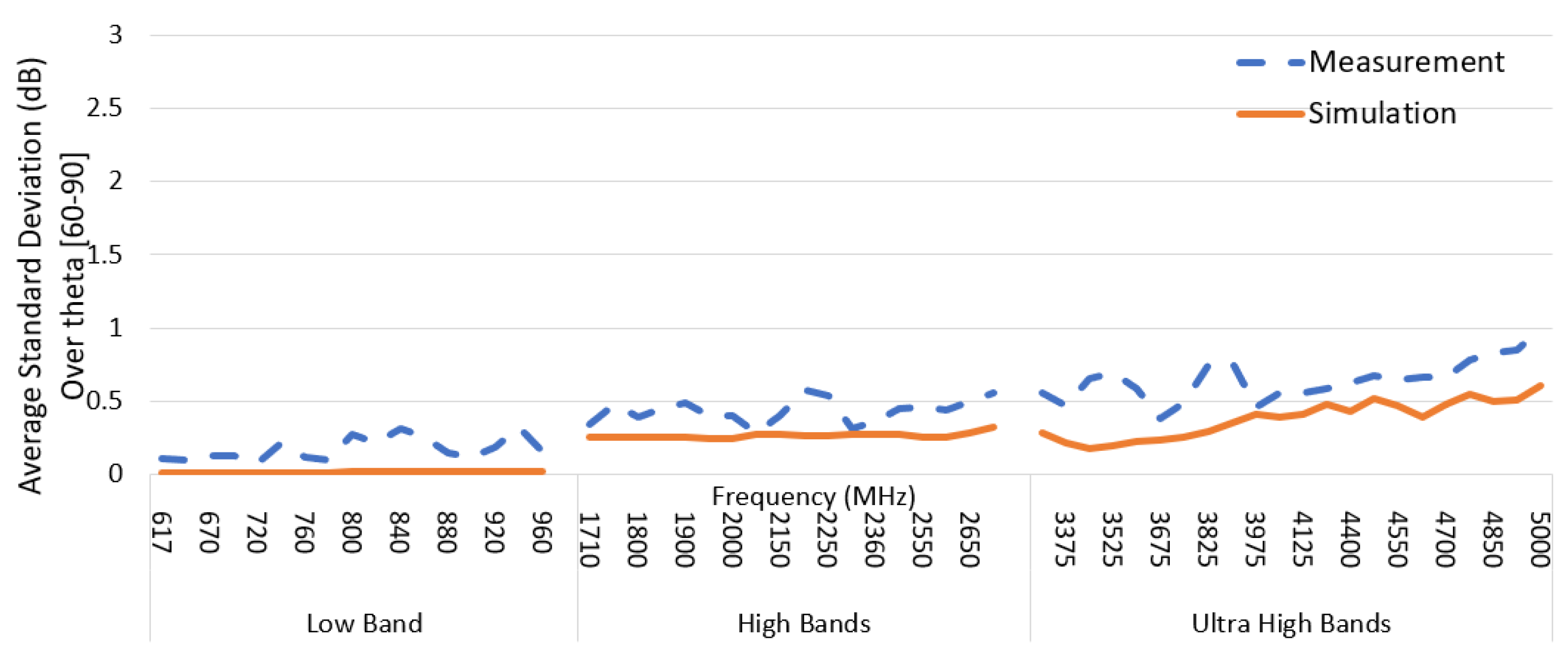
Publisher’s Note: MDPI stays neutral with regard to jurisdictional claims in published maps and institutional affiliations. |
© 2022 by the authors. Licensee MDPI, Basel, Switzerland. This article is an open access article distributed under the terms and conditions of the Creative Commons Attribution (CC BY) license (https://creativecommons.org/licenses/by/4.0/).
Share and Cite
Abdul-Rahman, E.; Aloi, D.N. Design of a 5G Sub-6 GHz Vehicular Cellular Antenna Element with Consistent Radiation Pattern Using Characteristic Mode Analysis. Sensors 2022, 22, 8862. https://doi.org/10.3390/s22228862
Abdul-Rahman E, Aloi DN. Design of a 5G Sub-6 GHz Vehicular Cellular Antenna Element with Consistent Radiation Pattern Using Characteristic Mode Analysis. Sensors. 2022; 22(22):8862. https://doi.org/10.3390/s22228862
Chicago/Turabian StyleAbdul-Rahman, Ehab, and Daniel N. Aloi. 2022. "Design of a 5G Sub-6 GHz Vehicular Cellular Antenna Element with Consistent Radiation Pattern Using Characteristic Mode Analysis" Sensors 22, no. 22: 8862. https://doi.org/10.3390/s22228862
APA StyleAbdul-Rahman, E., & Aloi, D. N. (2022). Design of a 5G Sub-6 GHz Vehicular Cellular Antenna Element with Consistent Radiation Pattern Using Characteristic Mode Analysis. Sensors, 22(22), 8862. https://doi.org/10.3390/s22228862





